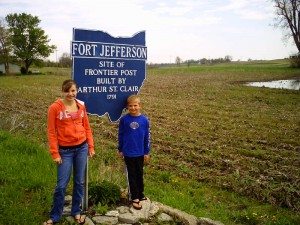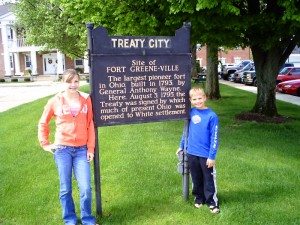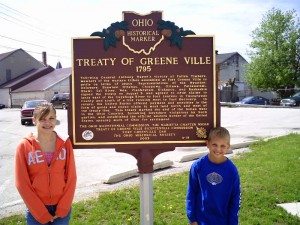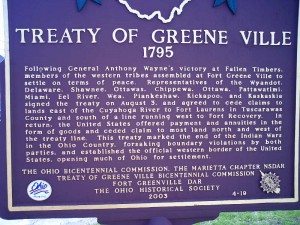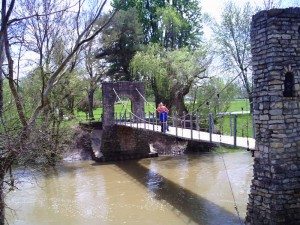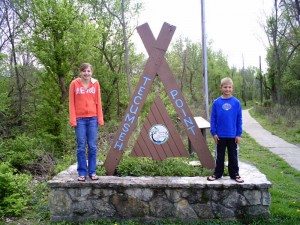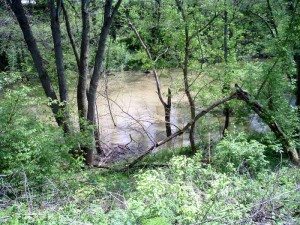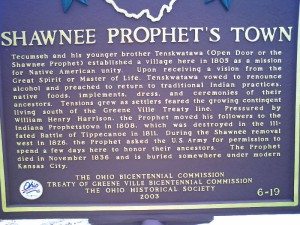One of the great things about life is the unexpected treasures. When we get up in the morning, we can have the greatest plans prepared and often we follow them exactly as we planned. But when things take a different turn, it often turns a day full of memories.
One Saturday a few years ago, my wife and two youngest daughters spent the day shopping with my mother-in-law. Since my oldest daughter and son were with me and all baseball games were rained out, we decided to take an historic adventure. We headed to the Levi Coffin House in Fountain City, Indiana only to find that it doesn’t open until June. Then we decided to go to the Richmond Museum because they have some really neat exibits, but then we saw the sign for the “Highest Point in Indiana.” We headed out into the country and drove for miles and miles until we came up on the small community of Arba, Ohio.
No chance of finding the highest point in Indiana there, so we turned around. There was a sign going that direction that told us to turn again. I have no idea why there wasn’t a sign coming from the other direction. So, once again we went for miles and miles. We could tell we were gradually going uphill all the way, but there were no signs. Hitting the Ohio state line once again, I decided we would follow the line of colonial forts through that part of Ohio. As you may or may not know, there was a line of colonial forts from Cincinnati to Toledo, which made it easier for the newly formed permanent army of the United States to make the Ohio Territory safe for settlers. Malarie and Kaleb were up for the adventure, so we headed for our first marker. It was almost like we were on a photo scavenger hunt.
After coming off the country roads and to a main highway, we headed straight for the sight of Fort Jefferson. As you can see from the picture, there was nothing more than a sign, but with a little imagination we could see the fort standing by the marsh lands.
The following is from Ohio History Central:
In October 1791, General Arthur St. Clair ordered the construction of a fort roughly six miles south of modern-day Greenville, Ohio. He intended to use the site as a supply depot for his campaign against the Miami Indians. The fort was a rough square with the walls approximately one hundred feet in length. St. Clair’s men also built blockhouses on each corner of the fort. Originally called Fort Deposit, General St. Clair preferred to call the stockade Fort Jefferson.
After the fort’s completion, St. Clair’s army moved against the Miami Indians. On the morning of November 4, 1791, natives under Little Turtle and Blue Jacket attacked. They easily drove the Americans from the field. The American survivors fled to Fort Jefferson for safety, but they found no food or medical supplies and quickly departed for Fort Washington. This battle became known as St. Clair’s Defeat. He force suffered 647 killed soldiers and 271 wounded men out of 1400 participants in the battle. It was one of the worst defeats of the American military at the hands of Native Americans.
For the next three years, American soldiers manned Fort Jefferson. Conditions were difficult as Native Americans sought to drive the men from the area. The natives did all they could to prevent supplies from reaching the embattled soldiers. The United States government hoped to use Fort Jefferson for attacks on the hostile natives as well as protection for white settlements in the area. It was an important supply depot for Anthony Wayne and his army in 1794 as they sought to punish the natives for St. Clair’s Defeat.
After leaving the sight of Fort Jefferson, we headed north toward the sight of Fort Greene Ville. We found the sign at the edge of downtown Greenville, right in front of the municiple building. If I understand correctly, that point was a corner of Fort Greene Ville and the fort followed the banks of the Mudd Creek past where the creek forks with Greenville Creek. The fort was built by General Anthony Wayne. It was “the largest log fortified structure ever built, encompassing 55+ acres of land enclosed by wooden stockades and surrounded by 8 blockhouses. The fort stood for six years and was partially rebuilt during the War of 1812” (http://www.DiscoverOurLegends.com).
The reason the fort was built was because there were more and more whites coming into western Ohio in the 1700’s. The Native American tribes that were already there began to realize that their ways of life were in danger and began to clash with the settlers. President Washington sent General Wayne to handle the uprisings. Wayne built the Greene Ville Fort in 1793.
In August of 1794 , the Legion of the United States, under the command of General Wayne engaged the Indians in northern Ohio at the “Battle of Fallen Timbers.” This decisive battle brought an end to some of the hostilities, and treaty negotiations soon began.
In this monumental fort, the famous Treaty of GreeneVille (also named the Wyandot Peace and Friendship Treaty) was signed by Wayne and chiefs from the Woodland Indian tribes on August 3, 1795. This treaty opened the Northwest territory to white settlers.
There were other historical figures present at the signing of the Treaty of Greene Ville. William Henry Harrison, who would one day be elected president of the United States, was a lieutenant and served as aide de camp to Wayne. William Clark was a lieutenant of infantry. Meriwether Lewis was a new enlisted soldier in the spring of 1795 and reported directly to Fort Greene Ville. Lewis and Clark fought in the same division at the Battle of Fallen Timbers and will be remembered forever because of their expedition into the Pacific Northwest. On the Native American side, there were also notable historic figures. Little Turtle (Michikinikwa) was a chief of the Miami tribe. He was the main war captain of the Indian forces in the early uprisings against the settlers, but eventually called for tribes to make peace with the whites. When the tribes fought against Wayne’s forces, he handed over leadership to Blue Jacket. According to a pamphlet picked up at the Garst Museum, as Little Turtle “signed the Treaty of Greene Ville he declared, ‘I am the last to sign it, and I will be the last to break it.’” Blue Jacket was the leader of the Indian forces at the Battle of Fallen Timbers. He was “a strong ally of the British from whom, it is said, he held the commission and half pay of a brigadier general.”
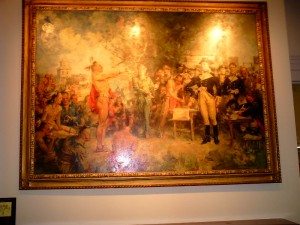
This painting hangs in the Garst Museum in Greenville, Ohio just above the fire place in the Garst House Parlor. The following information comes from the free pamphlet Guide to the Painting “The Signing of The Treaty of Greene Ville” by Howard Chandler Christy prepared by the Department of History Ohio State Archaeological and Historical Society, published by The Darke County Historical Society, reprinted January, 2007.
Howard Chandler Christy’s interest in art began early in his youth. While a young boy he displayed a native talent for drawing. At the age of 20 he went east to make illustrating his livelihood. He contributed to various periodicals, including Scribner’s Magazine, Harper’s Magazine, Collier’s Weekly, Cosmopolitan, and Hearst’s magazines.
About 1920, he turned from illustrating to portrait painting. His list of portraits is a list of many of the noted men of the twentieth century. Presidents, Cabinet officers, Congressmen, industrialists, and a large number of other well-known figures.
The artist established himself as a painter of historic scenes when he produced the large painting, “The Signing of the Constitution.” This historic painting was commissioned by Congress in 1939, and hangs in the national Capital in Washington.
The General Assembly of the State of Ohio authorized the Ohio State Archaeological and Historical Society to secure a painting of the Signing of the Treaty of Greene Ville in January 1945; instructing that Howard Chandler Christy or some other eminent Ohio artist should be commissioned. Mr. Christy was immediately chosen to paint the picture. The necessary historical research for the scene to be portrayed was provided by the historians of the State Historical Society. The picture was completed in July. After its unveiling at Greenville on August 3, it was to be hung permanently in the state Capital at Columbus.
The last sentence makes it sound like the real painting isn’t hanging at the museum, but it sure looked real to me. I guess it could be a reprint, but the texture seemed to be real. I wish I had read the information while I was there, so I could have asked. Oh, well, live and learn.
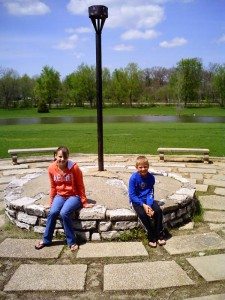
In the city park of Greenville, Ohio we crossed a swinging bridge and hiked a short trail to a hillside where the Alter of Peace stood. This place was the site of where General Wayne kept a torch burning to symbolize peace as the Native Americans and U.S. officials came to terms on the treaty.
Across Mud Creek from Greene Ville Fort, Tecumseh burnt fires in protest to The Treaty of Greene Ville. Tecumseh had fought in the Battle of Fallen Timbers but refused to participate in the signing of the treaty. Learn more about Tecumseh.
I even took this picture to show how hard it would have been to cross Mud Creek and go from Fort Greene Ville and Tecumseh’s fires.
Tecumseh and his brother established this town just outside of Greene Ville as a place of unity for the tribes worried about the white settlers. This town existed from 1805 to 1808. This spot is now a part of the Shawnee Nature Center. Eventually Tecumseh and (brother) were asked to move Prophet Town to a place in Indiana. They moved, but the town was burned during the Battle of Tippacanoe. Learn more about the Prophet and Prophet’s Town.
We learned a lot about the early history of Ohio and Indiana. We also visited more places in the area, but I will save that information for later.
